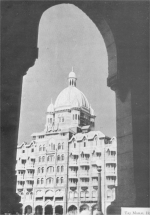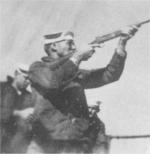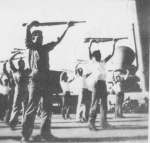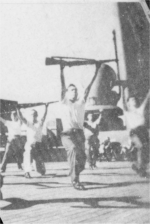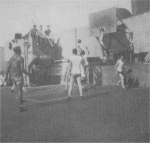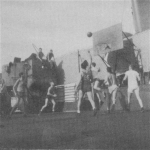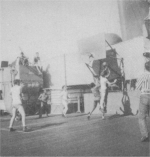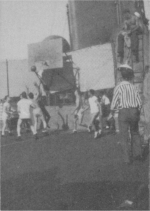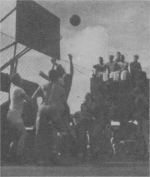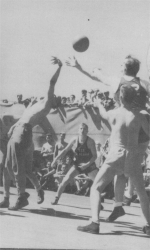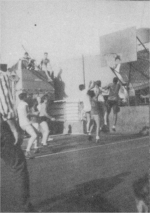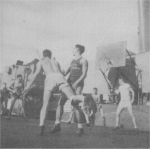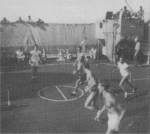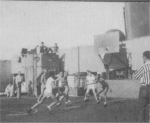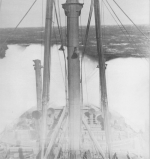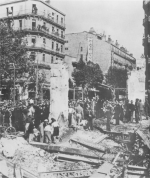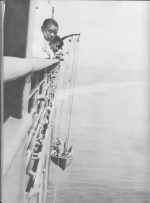Please report any broken links or trouble you might come across to the Webmaster. Please take a moment to let us know so that we can correct any problems and make your visit as enjoyable and as informative as possible.
NavSource Online: Service Ship Photo Archive
AP-22 Mount Vernon
Cruise Book 1941 to 1946
Page 7Contributed by Robert E. Houle, CM2c, SSMT1c
All images in this section are taken from the cruise book. Narrative has been transposed and added to the photos where appropriate.
Click on Thumbnail Image to See Enlarged Picture
"After one month at sea, interrupted by only two days in Melbourne, the 'Mount Vernon' docked at Ballard Pier in the harbor of India's most famous city--Bombay. Then began a two week education in the art of bargaining which made the members of the crew expert tradesmen. It had been rumored that diamonds, rubies, and other valuable articles could be had at a cheap price in India, but it soon became apparent that the shopkeeper were selling nothing cheap. The rupee, worth about thirty cents, and the anna, worth a little less than two cents, became familiar words to the ship's personnel, who soon learned that they were not expected to pay the price first asked. The Indians were masters of the art of bartering, and could wear a pained expression that would give the buyer the impression he was stealing from them rather than purchasing an article.
The first liberty party returned to the ship with ornate tables and baskets, silver filigree pins, ivory carvings, and brassware with colored designs. The favorite souvenir was a mounted mongoose-snake fight.
Night found many at the Taj Mahal Hotel, or the Green Hotel relaxing with a cool drink of South African brandy or gin. The drink was very different in taste from the usual American beer or bourbon, but it had much the same effect.
People in Bombay were strange in appearance and customs. On the streets women could be seen wearing a small jewel in the side of the nose just as in the States women wore earrings. Women also wore saris which they gracefully draped around them. Some of the saris were embroidered in a fine gold thread and cost hundreds of dollars. In contrast to the expensive garments were the multitudes of penniless beggars.
Everyone walked around the scared cows, and the killing of them was considered a sin.
Such men as enjoyed playing the horses found that Bombay had a beautiful racetrack but the 'ponies' were not in the same class with those on tracks of Santa Anita.
There were many temples, rich in gold, silver, and jewels, for the sailors to admire. Crawford Market, where one could buy anything from flowers to monkeys was an unusual sight. The bazaar consisted of peddlers on the street, shops which were mere stalls, and elaborate silver shops.
The ship sailed from the land of the 'hobba hobba' and 'bum boats' in company with the 'Mariposa'. Less than twelve hours after departure, an ammunition ship, near which the ship had been moored, blew up sinking and damaging several ships and starting large fires on the shoreline. Had the 'Mount Vernon' been there she would probably have suffered serious damage.
Among the passengers embarked at Bombay were a group of Indian Hindus, whose customs and mode of life offered an interesting sight on shipboard. Since it was necessary for them to cook their own food, they set about it at once. Only prompt action prevented their building an open fire on the deck forward of 'B' deck. They were then taken to the galley where they prepared their own dishes, while the ship's cooks looked on in amazement. Few of the crew envied the passengers their meals. Their staple diet consisted of curry and rice cooked with fish-heads.
Steam away from Bombay was not without its tense feeling of expectation, for at the time there existed a serious submarine menace in the Indian Ocean and the Gulf of Aden. Several ships had been recently torpedoed.
The trip from Bombay to the States was bound to be long. That no one doubted. When the ship, almost home, made a wide sweeping turn and headed southeast, all hope of an early arrival was doomed. 'Where was the ship going?' 'Had't the cruise, already a month at sea, been long enough?' 'Why was the ship diverting?' 'Diverting, that was it!', scuttlebutt streamed forth. Right it was. On May 14, the 'Mount Vernon' entered the Panama Canal, ending her Pacific Travels.
During the long weeks of the Pacific voyage, the athletic program of the ship was utilized to its maximum extent. War had emptied the swimming pool and brought the space and equipment devoted to recreation to a minimum, but due to ample deck space, athletic competition proved practical and popular.
Interest of the ship's commanding officers had always been reflected in shipboard athletics. One had been extremely interested in the traditional Navy sport of boxing. Another, whose interest followed volleyball, had notified officers of any such games by sending an orderly with the message: 'Captain's compliments. Volleyball will begin on the arena in five minutes.' During the Pacific cruise, however, basketball caught the interest of the crew and passengers, and, with the active support of the commanding officer, became the center of the most far-reaching athletic programs the ship had seen.
Such athletic pursuits were in addition to an extensive program of calisthenics each morning which kept the officers and men in top physical condition.
The Pacific cruise saw the first of the basketball tournaments, consisting of competition between divisions. Corpsmen of the 'H' division and deck hands of the Second division rated as the top teams in the initial round of play. With the development of scores of expert players, an All-Ship team was organized for competition with passengers as well as teams from other ships. Although many strong Army teams were developed aboard, only three times were the passengers successful in defeating the ship's enlisted squads. In the years to follow approximately thirty of the these Army-Navy games were played aboard. When the vessel steamed into the Atlantic, weather conditions, although often unfavorable, seldom caused cancellation of the program, and games were played many times in almost freezing temperatures.
OPERATIONS ATLANTIC were, for the most part, varied. At times, the seas mounted and showed power unsuspected; the waves tossed the ship as if she were a piece of wood; they sprayed eighty-five feet to her highest deck; they slowed her travel. Such was the trip of the 'Big Roll' at which time the ship listed thirty-two degrees before righting herself. At times, however, the silence and the calm were hypnotic; the sea brought back memories of the quiet lake off in the woods at home.
Once in a while, the wind blew the wrong direction from the Boston Fish Pier, or from the fertilizer plant in Norfolk, but the greater portion of the time, the breezes were from the sea, without the benefit of discomfort of having crossed land in the immediate vicinity. Most of the time spent on Atlantic operations was spent ON the Atlantic, shuttling our troops between Boston, New York City, and Norfolk on the stateside and Liverpool, Naples, and Marseilles over there. Occasionally, the routine was pleasantly interrupted by a deviation to another port of call: Glasgow, Oran, or Gibraltar or by a varied passenger list.
Red Cross Workers, en route to the European Theater joined the ship's company in post-victory dances on the sun deck. USO troupes presented their productions for the entertainment of all present. Casualties we carried, supplying them with complete medical service uninterrupted between foreign and home base. Displaced persons we carried to their homelands; prisoners we carried to our land.
All foreign ports of call showed physical affects of war and bombings. They revealed, too, the history, architecture, and culture of the people.
The troops which stormed the Normandy beachheads 'D' Day were reinforced by men en route to England aboard the 'Mount Vernon' and the other ships under the command of Naval Transport Service (Atlantic) that day. She became one of the span of ships across the ocean, an important one. Six thousand men a trip guaranteed her importance as a troop carrier. These men embarked at Boston, but they were the men of the Eastern cities and the Western plains, the Northern factories and the Southern hills.
The majority of troops and passenger personnel carried expressed their approval or disapproval of the ship verbally. One, an officer of the Italian forces, however, leaped overboard with suicide or escape to a passing ship as his intent. Adroit ship handling by Lieutenant (jg) Kayser and expeditious lowering and operating of the motor whaleboat by Coxswain Hughes resulted in a successful rescue at sea.
Following the orders of Radio Washington, on 26 January 1945, the 'Mount Vernon' altered her course and proceeded through cold fog to stand by a tanker afire at sea. Preparations for boarding with fire gear were completed, but not carried out as the 'Mount Vernon' was ordered relieved by a Coast Guard fire boat. The relief arrived only after all hands aboard were benumbed by cold."
This page is created and maintained by Gary P. Priolo

|
